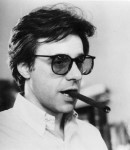▼
The Various Lives of Anthony Burgess ● by Brandon Cook
Back in October, David Bowie published his 100 Must Reads in what The Guardian referred to as “the next chapter… in the well-known David Bowie story.” Is it really that well known? The glam rocker-cum-Space Oddity, cum-Ziggy Stardust-cum neoclassicist-cum “best-dressed Briton in history isn’t exactly basic textbook material. No one thought to mention this, nor why anyone still cared about finding out about it, but the narrative was the same everywhere: rockers can read.
This is evidently surprise enough to merit Big News, although what exactly was read is little more than the stuff of middle-aged book club frequenters. Bowie’s list — although graciously deficient from the bourgeois literature touted from many journalistic and celebrity top reads — held a ranking that surprised no one. There are trending or trended novels by Junot Diaz and Ian McEwan, histories, and lots of books about music.
Reading through the list, I discovered two entries that startled me. These were A Clockwork Orange and Earthly Powers, both by Anthony Burgess. One of these is somewhat unknown in the Western canon while the other is relished today, although less for literary merit than for the fact that it was made into an explicit film in which Stanley Kubrick gets away with showing full nudity in the early 70s.

●
This inclusion of Burgess is not groundbreaking. It’s quite inevitable. Most of us have probably read A Clockwork Orange and reacted with similar blends of shock or praise or confusion. Fewer of us have returned to the novel and laughed out loud, or shaken out heads in silent disbelief that a writer can pack Russian and Beethoven and gang rape and quips paraphrased from James Joyce’s Ulysses into a novel less than three hundred pages long. Even fewer of us realize that Burgess needed only three weeks and thousands of cigarettes to pound out those less-than-three-hundred pages. None of us, having known or experienced any of the above, walk away from Clockwork without an opinion.
I like to pride myself as a cut away from the crowd when I confess to not only being the reader described above, but a reader so obsessed with the name Burgess that any mention of the former makes me go weak in the knees. Hence my being startled in seeing the name next to Bowie’s. I imagine that many readers experience a similar phenomenon when they have been married to a writer as long as I have been married to Burgess.

Burgess
●
But I am not so coy that I cannot admit my love as the fan boy obsession it really is. The almost daily studies I’ve done for nearly a decade are as involved as reading critical approaches to Burgess’s modernism, to as light as briefing articles about his opinions on the Eurovision song contest. I confess a paranoid difficulty in making an opinion for which I have not first consulted the author. Nothing yielding in Burgess’s books or articles, I take an uncomfortable stab at originality and remain dissatisfied with the result for days. In the event of a successful find, I quote the writer feverishly — it was him who taught me useless words like “confabulation,” “concaptian,” “Manichean”—and revel in this brand of surrogate intellectualism.
Like the squirt of ketchup applied to a basket of fries, Burgess has become my necessary mental condiment.
Out of the context of his books or articles, Burgess’s name flashed on something as insignificant as a celebrity reading list guarantees me of the writer’s immortality. People do not take these things lightly. It also insures my own sanity as one of the few who still clings to a writer most other readers see as homely, elitist, pedantic, dry, old-fashioned, unforgivably British.
Burgess would have objected. He most certainly was not British. The British people were educated in Cambridge and Oxford and lived their lives in Burberry and London. He was from Manchester, and his people were salt-of-the-earth Mancunians. Their ancestors had scraped off a living in the cotton mills that pockmark the city; had drank their pints and smoked their cigarettes in its ugly pubs, and dammit but wouldn’t their children do the same. But Burgess was proud to call Manchester his home — so proud that after completing his military service in 1946 he turned tail and never returned.
On a stormy Friday night in October, I puddle-hopped from Dublin to Manchester airport for a weekend pilgrimage. My destination was the International Anthony Burgess Foundation, a impressive name that conjures visions of a collegiate estate where academics drink tumblers of Bombay Sapphire and discuss in Nadsat the merits of Somerset Maugham and Evelyn Waugh. The Foundation is relatively new but it boasts an impressive online blog and a superbly narrated podcast that can only be faulted for having produced only episodes. Having contacted the institute weeks before to arrange my visit at the private reading library, I considered myself something of a guest of honor.
The International Anthony Burgess Foundation is not a collegiate estate. If you walk down Manchester’s central Oxford Road, take the narrow side street advised to you by your hostel receptionist, pass beneath the overpass, hug the path next to the rusted fence, and continue straight ahead until you see the decommissioned smokestacks in the distance, you may pass a smallish building on your left whose squareness and eye-popping red resemble a Lego castle you engineered in your youth. You may wonder if this is really the place that boasts the scholarship of one of the twentieth century’s cleverest intellectuals and most celebrated man-of-letters and then you will see the inscription on the building’s glass façade:
Literature is not easy but without Literature we are lost.
Greetings do not get more ominous than this. Hell might as well have employed Burgess to write the “abandon all hope.” The words are filled with typical Burgessisms: ironic understatement — “not easy” must be how Burgess described his output of two thousand words, every day for thirty-three years; “lost” is probably shorthand for “royally fucked” — ; snappy brevity; a theme of intellect-as-hero.
p
Like Dante, I paused only to admire the words before I stepped inside. Or tried to. Ten minutes past closing time and the door was still locked. I waited until someone on the inside opened the door for me, looking apologetic but confused. The Foundation didn’t usually get visitors so early, he told me.
It is a cliche to say that stepping into the building was like stepping into another world. Nevertheless, I pardon myself for having used it. This was Burgess’s world. Like a reminder of the city he abandoned, the grey, cold, Manchester morning seethed agains the windows—inside, the wallpaper was the burnt-orange color of an Asiatic sunset. There were books in five languages stacked in shelves on one wall, a bar on the other styling a beer called (what else?) “Earthly Powers,” and a Steinway I could just make out in the room adjacent.
It was all here — Burgess’s polylingual erudition, his career as an expatriate in the colorful Asian Pacific, his lifelong passion for music, his vice of good alcohol matched only by his vice for cigarettes (matched only by his vice for sex). And in the as-yet waking hours of the morning, despite the promises of the man who had let me inside that someone would be there to help me, it was utterly bare. “To be left alone is the most precious thing one can ask of the modern world,” I would have been reminded.
Seldom would the writer have the opportunity to enjoy the benefits of his own advice. After his war career, Burgess took a job supervising youngsters at an English grammar school. Never the kind of teacher to hold a job, he held several: supervising sports, teaching literature, and organizing drama productions, as well as submitting occasional articles to a local newspaper. But England was weighing on him and he was growing depressed. His nights were spent getting drunk on cheap cider and filling out other teaching applications.
Once, he received a letter informing him that he had been accepted into the British Colonial Service as a teacher in Malaya. This confused Burgess. He could not recall applying for the British Colonial Service as a teacher in Malaya. He wired back: I did not apply for this position. The British Colonial Service replied: You are expected to fulfill the position. Burgess again: Oh no I won’t. The British Colonial Service: Oh yes you will.
Burgess concluded later that he was most certainly drunk when he submitted his application. As is so often the case in his life, the sheer chance of the incident, its humor and outrageousness seem to be scenes that only the writer could have written. Reality, it seems, is always the ultimate fiction. But that didn’t stop Burgess from trying to rival his reality by dramatizing the events of his life for his novels and later for his autobiography. Authenticity is a problem with the author only if you really do care about the truth, which more often than not you don’t. Burgess was a compulsive liar with a writing problem.
Still he must have simmered on the inside knowing that he would never produce a character as original as those that life threw at him. And life threw a lot at him: drinking companions in the form of William Burroughs; a cuckolder in the form of a whining Dylan Thomas; the transvestitic, Malayan servant Yusef — Mohammad in his novel Time For a Tiger — who fell desperately in love with Burgess and then tried to slip him a love potion when his advances weren’t returned.
Malaya also threw what is typically seen as the defining moment of Burgess’s carreer. 1958 saw the writer teaching in Brunei. He was dehydrated from the heat and from excessive drinking, stressed by problems with the wife, and generally irritable: a transvestitic Malayan servant, whose advances hadn’t been returned, was suing the author for libel, despite the fact that the servant was illiterate and couldn’t actually read the offending text. According to Burgess, this was all ample reason to lie down on the floor and close his eyes in frustration.
The authorities and the doctors said something different. They said ‘collapse.’ They said ‘inoperable brain tumor.’ They said ‘one year to live.’ Burgess, who later revealed that he never really believed this sentence, was nevertheless spooked enough to do something with that one year. Teaching was out of the question — who would contract the dying professor? — as was travel. It was too expensive, and he was going to have a widow who needed providing. What he needed was not a gala or a send-off, but a means of support. Writing was hardly the natural answer yet it fit the criteria. Besides, Burgess had already had early success publishing novels. A stash of books could produce enough royalties to suit his wife, if he produced one, say, every month. Sixty-thousand words for a mid-sized novel was two thousand words a day, every day.
There wasn’t a moment to lose.
The Burgess reading room was like a bomb-proof miniature of the Library of Alexandria. More realistically, it was a basement garage stuffed with the kinds of odd crap people tend to amass over the years. Needless to say, the difference between the Burgess reading room and your garage was that this was not odd crap. This was a wall filled with hundreds of critics’ copies Burgess had reviewed to pay for his gin and to fill the pages of the Manchester Guardian and the Sunday Observer. There was a section containing James Joyce in most European languages and editions of Ulysses dating back to the 1930s; another wall crammed with hundreds of vinyl records of mostly classical music, but also the occasional Beatles record.
Miscellaneous pieces were in helpless abundance: in the corner a harpsichord which I attempted to play; on a table, a jar containing hundreds of old matchbooks. “There is a sense, however, in keeping a bowl of such trophies,” Kenneth Toomey muses in Earthly Powers, “there are addresses and telephone numbers there, as well as a palpable record of travel helpful to an old man’s memory.” Let it be known that Toomey was speaking about these matches.
I set my notebook down on one of the desks, and an inventory of memorabilia I had requested was delivered to me by the museum’s amateur curator — a lovely woman with quick eyes who had taken the position because she needed a job. Aside from A Clockwork Orange, she hadn’t known anything about Burgess before she started.
Perhaps she wouldn’t have taken the job had she known just how massive a sorting Burgess would prove. Those who explore Burgess in any depth are usually bowled over by the sheer amount of stuff he managed to produce: thirty-three novels, two autobiographies, four biographies, several texts on linguistics, numerous translations, countless reviews (the majority of which remain untranslated from the Italian), and most impressive, a host of musical compositions including several symphonies, now lost.
Perhaps this is a surprise to some. Burgess always considered himself more composer than writer—his artistic career began not with a bang but with the sexy harmonics of Claude Debussy’s Prélude à l’après-midi d’un faune which he first heard when he was a youngster and which reduced him to tears. He was a determined composer ever since.
A determined composer but, alas, not a very good one. On scratchy cassette reels, we listened to bizarre concertos for harmonica and recorder; fanfares that might have come out of the rubbish piles of Stravinsky or Schönberg’s worst; piano works that quickly got tired of and changed out of their themes the way a girl changes clothes. Some of it was vaguely impressionistic — and here I detected quotes of Debussy — but if it was the stuff of dreams those dreams were troubled and anxious, and filled with visions of lewd sex and violence.
And it was gorgeous. Gorgeous, from the skittish melodies and the atonal exercises and the squeaking repetitions of a recorder solo, because it couldn’t have come from anyone other than Burgess. At its most delightful, Burgess’s work makes no apologies for being bad.
Nor does it ever need to apologize for being rude, for this is what one gets himself into no matter what volume of Burgess he chooses. “I myself am a sort of high-class prostitute,” the author chirped. This would account for why he was never one to shy away from private details even when they weren’t, strictly speaking, necessary to scholarship. His biography of James Joyce, for example, is liable to carry on with an analysis of the language of Finnegan’s Wake and its use of polysyllables to mimic the currents of flowing water before reminding us that oh, and by the way, did you know that Nora Barnacle publicly masturbated Joyce on their first date? On the other hand, you probably won’t find a more bookish, unsexy analysis of Marilyn Monroe anywhere else.
No one ever told the scholar he had to play it safe.
Someone might have told him to at least play it legal, but we can be thankful that if they ever did, Burgess wasn’t listening.
Following the diagnosis of his ‘brain tumor,’ Burgess had managed to produce nearly seven novels. It was suggested to him that in the interests of not flooding the market he should take up a pen name. Joseph Kell was born. Years after the tumor was supposed to have killed him and Burgess, still alive to the disappointment of some, took up a book reviewing position with the Yorkshire Post, Joseph Kell remained a practicing author. A prodigious practicing author, actually, with a new book entitled Inside Mr. Enderby that was to be the first in a trilogy, later quartet.
In 1963, Enderby and a host of other books arrived on Burgess’s doorstep for their fortnightly reviews. The author picked up the Enderby volume from his doorstep, frowning in confusion, before it occurred to him that, ah yes, his publisher was playing a joke on him. Kell and Burgess and Enderby: all caricatures, to a degree, of the real man Anthony, all under the same review, all in the same paper. It was a joke that he wanted apart of.
And so Burgess wrote the review, and the Yorkshire Post published it. “This is, in many ways, a dirty book,” it read. “It is full of bowel blasts and flatulent borborygums, emetic meals… and halitosis. It may make some people sick, and those of my readers with tender stomachs are advised to let it alone.”
Hardly flattering stuff. Burgess was probably pleased with the rather ruthless self-critique. He was probably less pleased when someone at the Post got whiff of the fact that Burgess the reviewer and Kell the author were one and the same. Burgess might have contacted his editor: I was under the impression this was all in good fun.
His editor might have replied: No one was laughing. Burgess again: Oh yes they were. The editor: Oh no they weren’t.
A stuffy, self-important article about the incident confirmed the editor’s opinion. “Pluralistic reviewing is unfortunately also known in those papers and journals which cloak their reviewer’s names in anonymity. But writing revews of one’s own work is not common….” Burgess was promptly canned. The fuddy-duddies won the day.
Need it be said that it was Burgess who won the war? Later, he might have even looked upon his canning as a blessing in disguise meant to boost him out of the world of journalism and into the career of a professional writer.
I hesitate, however, to label Burgess as just the professional writer. “I am a writer, a critic, and a Shakespeare-lover,” he said. This is telling. One cannot forget that Burgess was a great writer on and, occasionally, of literature, but that he was better still at enjoying it and enabling others to enjoy it as well. I label myself as one of those others who came to literature by virtue of Burgess’s guiding hand. It was that hand that I held through Joyce’s Dublin, the same hand that pushed me confidently towards T.S. Eliot, Shakespeare, Marlowe. It is the guidance of that hand that I remember even now, having long since accepted Burgess’s tenet that art and learning are ends unto themselves, and having determined to uphold the preservation of art for art’s sake.
That hand was big — literally, as I witnessed from the cast replica held in the museum — and figuratively, for it had to hold all the small hands of his disciples. It was with joy that I met some of these flipping through the telegrams and fan-mail Burgess preserved throughout his life.
The range of these correspondences is breathtaking and an article even as rambling as this is too small a space to feature half of what I read: postcards from Angela Carter and Graham Greene; well wishes from Stanley Kubrick; an eerie one-liner from Thomas Pynchon; a veritable letter bomb from Hunter S. Thompson. These were fun.
The fan-mail was astonishing.
Next to the famous names of the Burgess’s contacts, these people were strikingly real. A German student, at odds with his professor over the interpretation of A Clockwork Orange, implored the author for aid: “my success in the English Subject and so my whole school career depends on your answer (I know this sounds very dramatic but unfortunately it is true).” Burgess cleared the confusion and responded heart-fully: “My time is not precious and I have not been wasting it in reading your kind letter.” A different kind of mail, an essay on the Orange from a thirteen-year-old girl, takes to Burgess’s language more readily than it does English: “Alex who is 15 goes around at night with his four droogs crasting and tolshocking (sic) lewdies who they might see there.”
How many of us figure into the days of those we worship? How many of us ever get to see our presence known in the eyes of those that mean the most to us? I imagine most of us, if we factor as presences at all, flash in and out of these lives like faulty light bulbs. I wonder sometimes if this is the paradox of showing devotion, that it interrupts attention but does not move or direct it.
In a lifelong battle against his lungs, Burgess finally won when he destroyed them completely on November 22, 1993. “Each man kills the thing he loves;” but there was nothing about his health that the writer loved. In his youth he was frail and colorblind; in middle-age he was frail and colorblind and probably dyspeptic: a fighting image, if not incarnation, of his poet Enderby.
Still, I cannot help but imagine how the writer would have got on today barring that he had failed to smoke himself out. He’d still be writing, not out of love but out of obsessive-compulsion. He’d dismiss modern music (shopgirl pop), modern film (civilization’s last death rattle) and modern politicians (utilitarian philistines). He’d praise sexual liberality but couldn’t the Victoria’s Secret Fashion Show afford a passacaglia or a fantasy impromptu instead of the usual lump of electric muddle?
And I wonder what I would say to Burgess if given the chance. Why did you become a writer? What advice would you offer the younger generation of writers? How the hell did you manage two thousand words a day?
I don’t think so. I’ve read enough Burgess to know what answers the public writer can give me. Ten years ago these answers were my stimulants; now they bore me. The process of worshiping the writer is the process of dissolving the writer until he loses his unimpeachable wonder and becomes, by another miracle, just a man: a man you can love because you can see yourself becoming him later. I’d probably ask Burgess how he avoided paying income tax when he was living abroad.
We spent eight hours in the book vault before emerging for tea. By tea, I mean a pint of IPA and a brownie the size of a hand, or “rooker” in Nadsat. These were indulgences won by hard labor. I had excavated seventy years of art and articles that still hadn’t ever been green-lighted for publication. My fingers bore the smell old carbon copies and telegrams and, dare I say it, a whiff of the writer’s old cigarette smoke?
Taking out my book of notes and beginning to read at my table, I was interrupted by the soft intonation of an accent somewhere near the bar. I confess no good ear for detecting accents, but this was a voice that sounded familiar; I could detect its polish and articulation so very like Burgess’s own, and there was a seductively patrician quality to it: the sort of thing Americans love when they hear a British accent.
I walked to the bar and took a stab at guessing: are you the one I hear narrating the Anthony Burgess Podcast? Indeed, he was the one. I am not ashamed to admit that I gushed — did he know how good those podcasts were? How I listened to each episode twice, three times? How good it was, for the love of Burgess, to know there were other serious devotees out there in the great wide world?
My companion did not know; I probably embarrassed him by bringing it all so gushingly to his attention. I was thanked effusively for my support and told that, yes, it was rather a shame so few people knew about Burgess. The word, nevertheless, was getting out. Books were being published; experts were being consulted; lives would be changed. David Bowie had made a small endorsement. People would have no choice but to see in time.
But all that time could go to the devil for what I cared. For now, I relished the exclusivity. We, who saw this man for his invaluable, intellectual worth where others only deigned to see a dirty book, were but the chosen few. Burgess was ours; he belonged to the world, but it was we few who owned him. We few; we happy few; we band of Burgessians.
[Brandon Cook wishes to thank the International Anthony Burgess Foundation for its support in the writing of this article. He encourages anyone brave enough to holiday in Manchester to visit the Foundation.]
The Ryder ● February 2014


















